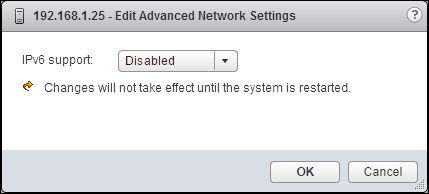Internet Protocol version 6 (IPv6) was developed to replace IP version 4 (IPv4). IPv6 addresses are 128-bit IP addresses compared to the 32-bit addresses in IPv4. IPv6 is becoming more common in datacenter network environments, and vSphere has included support for IPv6 since vSphere 5.x.
Enable IPv6 on the ESXi host.
Determine the vSphere features and services with IPv6 support.
Configure VMkernel interfaces to use IPv6.
By default, IPv6 support is enabled on ESXi hosts. If the IPv6 support is changed, disabled, or enabled, a host reboot is required. Enabling or disabling IPv6 is done on each ESXi host by editing Advanced Network Settings from the Networking management tab for the host, as shown in the following screenshot:

Once enabled, IPv6 can be configured for supported vSphere features and services. The following vSphere features and services support IPv6:
ESXi and vCenter Management
vMotion and vSphere DRS
Fault tolerance
vSphere HA
NFS v3 storage...



